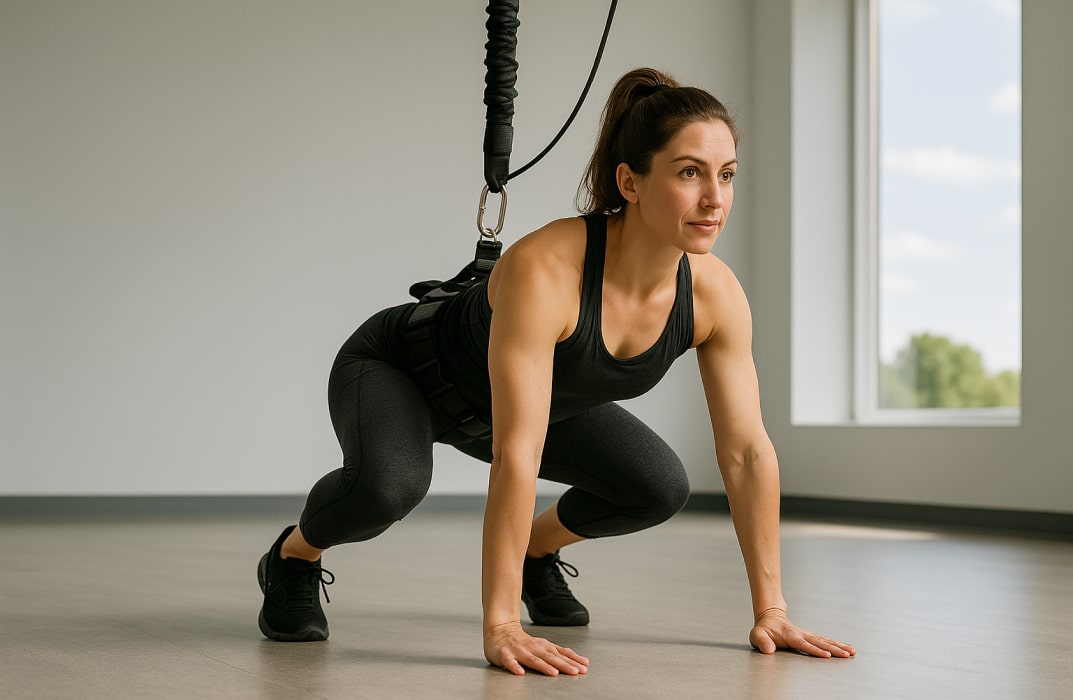Are You Earning Up to Your Potential?
Most personal trainers are undervaluing their time and skills. Our Personal trainer Revenue Calculator helps you find out what you should be making, and how to get there.
No guesswork. Just real numbers.
.jpg)
Bungee fitness is catching fire in 2026, and honestly, it’s easy to see why. It’s fun, energetic, and different from the usual treadmill or weightlifting session. People literally bounce around while working their entire body it’s cardio, strength, and a little thrill all rolled into one.
If you’ve ever thought about starting a bungee fitness business, now’s a smart time. Sure, you might be wondering about the bungee cost or which bungee workout equipment is worth investing in. Maybe you’ve even looked into a bungee fitness franchise but hesitated because of the bungee fitness franchise cost. Don’t worry we’ll break it all down.
In this guide, we’ll cover everything step by step: what equipment you actually need, how much it’ll cost, how to set up your space, and ways to get people through the door. By the end, you’ll have a clear picture of what it takes to launch a bungee fitness venture that’s fun, safe, and profitable without feeling overwhelmed.
{{fitness-challenge-generator-form="/blog-fitness-challenge-generator"}}
What is Bungee Fitness?

Bungee fitness is a workout that blends cardio, strength training, and suspension exercises using specialized sling bungee equipment. Instead of lifting heavy weights or pounding away on a treadmill, participants wear a harness attached to strong bungee cords that are anchored to the ceiling. The cords create resistance, making every squat, jump, or push-up more challenging but they also provide support, so the moves feel lighter and easier on the joints.
The result? A workout that burns calories, builds strength, and reduces impact on the knees, hips, and back. Many gyms describe it as “flying while you train,” because you can leap higher, move faster, and try fun movements that would normally feel impossible.
Different setups are available depending on your budget and space. Some studios invest in professional-grade bungee exercise equipment and bungee cord workout equipment, while others start smaller with just the essentials like harnesses, cords, and safety mats, and the right knowledge of equipment usage . Even with basic bungee cord exercise equipment, you can deliver an amazing workout experience to your customers .
In 2026, sling bungee fitness is more than just a trend. It appeals to beginners who want low-impact training, athletes looking for cross-training, and even people rehabbing from injuries. That wide appeal is one reason demand is growing so quickly and why investing in bungee workout equipment and classes can be a smart business move right now.
Also read: Creative Wellness Challenges to Kickstart Your 2024
Market Research & Business Planning
The fitness industry is booming. According to the Global Wellness Institute, the worldwide fitness market is projected to hit $9.0 trillion by 2028, with boutique studios (like bungee, pilates, and aerial yoga) seeing some of the fastest growth rates. This shows there’s real money in niche fitness businesses.
Here’s how to approach your research and planning:
1. Study Local Demand
- Check Google Trends and social media to see how many people are searching for bungee fitness in your region.
- Visit boutique studios (yoga, spin, aerial fitness) — if they’re busy, there’s likely an audience for bungee fitness too.
- Run small surveys or polls in local Facebook or WhatsApp groups to gauge interest.
- Schedule meetings or calls with local fitness professionals or potential clients to gather insights about the market.
2. Define Your Audience
- Young professionals who want fun and social workouts.
- Women (25–45) looking for low-impact but effective training.
- Fitness enthusiasts and athletes seeking cross-training.
- Rehab clients who need joint-friendly movement.
- Meet with at least one person from each target group to better understand their needs and preferences.
3. Build a Business Plan:
- Startup Costs: rent, permits, bungee cord workout equipment, marketing.
- Operating Costs: salaries, utilities, insurance.
- Revenue Model: per-class pricing, monthly memberships, or packages.
- Research where to shop for bungee fitness equipment and compare suppliers to find the best options for your studio.
4. Legal & Safety Requirements
- Get liability insurance (a must for all fitness businesses).
- Secure any business licenses or permits required in your state.
- Draft waivers for clients to sign before classes.
A strong business plan not only helps you launch confidently but also makes it easier to attract investors or partners — especially if you’re considering a bungee fitness franchise. Thorough planning and research will help your business succeed in a competitive market.
💪 Got an idea for a brand? Let's bring it to life.
Launch your own fitness app with FitBudd in minutes!

💪 Got your brand name? Let’s bring it to life.
Launch your own fitness app with FitBudd in minutes!


88% trainers worldwide gave us 5 stars
Transform your fitness business with the power of your branded app on iOS and Android.
Try for FREECosts of Starting a Bungee Fitness Business
When people ask, “What’s the real bungee cost to open a studio?”, the honest answer is — it depends. Your location, space size, and whether you go independent or choose a bungee fitness franchise all play a big role. But here’s a clear picture to help you plan.
Startup Costs (Independent Studio)
The first investment is your setup:
- Bungee fitness equipment (cords, harnesses, anchors, mats): $8,000 – $15,000
- Renovations and safety upgrades (flooring, ceiling reinforcements): $15,000 – $40,000
- Licenses, insurance, and certifications: $5,000 – $10,000
- Branding and marketing to launch: $3,000 – $7,000
Harness the power of a well-allocated budget to maximize your investment and set your studio up for long-term success.
On average, most independent studios spend $30,000 – $70,000 to get off the ground.
Monthly Running Costs
Once your studio is open, you’ll have regular expenses, including:
- Rent and utilities: $2,500 – $7,000
- Staff salaries: $3,000 – $8,000
- Ongoing marketing and equipment upkeep: $500 – $2,000
Strong financial management skills are essential to keep your monthly expenses under control and ensure your business remains sustainable.
That usually puts monthly expenses in the $6,000 – $15,000 range.
Franchise Costs
Going with a bungee fitness franchise gives you brand recognition and systems, but it’s pricier:
- Franchise fee: $25,000 – $50,000
- Total launch cost (including build-out and bungee workout equipment): $80,000 – $150,000
- Ongoing royalties: 5–8% of revenue
If you want more control and lower startup costs, going independent makes sense. If you’d rather skip trial and error and don’t mind higher expenses, a bungee fitness franchise cost may be worth it.
Essential Bungee Fitness Equipment

Your studio is only as good as the equipment you invest in. Quality matters here because clients need to feel safe and supported while they train, and having the right knowledge is essential. Cutting corners on bungee fitness equipment can hurt both your reputation and your bottom line.
At the core of any setup are the bungee cords and harnesses. These two items carry the most weight literally. Strong, commercial-grade bungee cord workout equipment provides resistance while giving clients the lift they need for jumps, lunges, and flips. Harnesses should be adjustable, comfortable, and secure, since every participant will spend the entire class wearing one.
Other essentials include:
- Safety flooring or mats to cushion landings and reduce joint impact.
- Carabiners and swivels to connect cords safely and allow full movement.
- Replacement cords and backup gear to avoid downtime if something wears out.
Some studios also invest in extras like resistance bands, weights, or crash mats to expand class variety. But if you’re starting lean, stick to the must-haves: harnesses, bungee exercise equipment, and a safe anchor system.
In 2026, sourcing has become easier, with multiple suppliers offering complete bungee cord exercise equipment packages for fitness businesses. Investing in high-quality gear upfront reduces long-term maintenance costs and gives your clients the confidence to come back for more.
Location & Space Setup
Choosing the right location is critical for a successful bungee fitness business, especially for accommodating clients with limited mobility . Unlike traditional gyms, bungee classes need vertical space for cords and jumps, so ceiling height is a major factor. Ideally, your studio should have at least 12 to 14 feet of clearance, and more is better if you plan to accommodate multiple participants or advanced moves.
The layout of the space is just as important. Each bungee station requires a safe zone so clients can move freely without colliding. A medium-sized studio should fit 6–10 bungee stations, leaving enough room for instructors to guide participants and for clients to land safely.
Key space considerations include:
- Flooring: Non-slip, cushioned mats or rubber flooring to reduce impact and prevent injuries.
- Visibility & accessibility: High foot traffic locations or near fitness hubs attract more clients. Shared spaces can reduce startup costs.
- Lighting & ventilation: Bright, well-ventilated areas keep energy levels high during workouts.
- Mirrors: Help clients maintain proper form while suspended.
Some entrepreneurs start in community centers or existing gyms to test the market before investing in a full standalone studio. Ultimately, the goal is to balance safety, accessibility, and ambiance. A well-planned studio not only prevents injuries but also makes the workout experience enjoyable, encouraging clients to return and refer friends.
Business Model and Franchise Options
When starting a bungee fitness studio, you’ll need to choose the business model that best fits your goals and resources. One popular route is purchasing a bungee fitness franchise. Franchises offer a proven business model, ongoing support, and access to a well-known brand, making it easier to attract clients and streamline operations. The franchise fee often covers essential equipment, instructor training, and marketing materials, giving you a head start in the competitive fitness industry.
Alternatively, you can launch an independent bungee fitness studio, which allows for greater flexibility in branding, class offerings, and marketing strategies. While this path requires more effort in building your own systems and reputation, it can be more cost-effective and tailored to your vision.
Hiring Staff & Training
Your instructors are the heart of a bungee fitness business, as they help attract and retain customers . Even the best bungee cord workout equipment won’t keep clients coming back if the teaching is poor or unsafe. That’s why hiring the right staff and providing proper training is essential for successful business ownership .
Start with certified fitness professionals who have experience in group classes, strength training, or aerial workouts. While prior bungee fitness experience is a plus, it’s not always required you can train them on the specific techniques and safety protocols of bungee workouts.
Key points for hiring and training staff:
- Instructor certifications: Look for accredited fitness certifications and, if possible, specialized training in bungee fitness or aerial workouts.
- Safety training: Ensure all instructors know how to adjust harnesses, anchor cords, and handle emergencies. Safety is non-negotiable.
- Class management skills: Instructors should be able to motivate participants, correct form, and create a fun, energetic environment.
- Ongoing workshops: Keep staff updated with the latest bungee fitness techniques, new exercises, and equipment updates.
It’s also a good idea to start with a small team and gradually expand as your classes grow. Many studios hire part-time instructors initially, then add full-time staff once memberships increase.
Investing in staff training not only improves safety but also enhances the overall client experience, particularly for those dealing with joint pain . Skilled instructors make workouts enjoyable, challenging, and safe, which drives retention and builds a strong community around your bungee fitness business.
Technology & Digital Tools for Studios
In 2026, technology plays a huge role in running a successful bungee fitness business. From scheduling classes to managing memberships, the right digital tools can save time, reduce errors, and even increase revenue.
Most modern studios use apps for:
- Class scheduling: Clients can book classes online, see availability, and even switch sessions if needed.
- Membership management: Track payments, monitor attendance, and manage packages or loyalty programs.
- Virtual classes: Offering live or recorded bungee workouts lets clients train from home, expanding your reach beyond the studio walls.
- Reminders & notifications: Automated emails or push notifications reduce no-shows and keep clients engaged.
Example: One studio integrated a popular scheduling app and noticed class attendance increase by 25% within two months. Clients appreciated the convenience of booking online, and instructors could manage classes more efficiently without phone calls or spreadsheets.
By embracing digital tools, your studio can improve operational efficiency, enhance client experience, and build a professional, modern brand. Technology is no longer optional it’s a key component of growth in 2026.
Marketing Your Bungee Fitness Business
Opening a studio is only half the battle you need clients walking through the door. Marketing is essential, especially in 2026, when fitness trends are competitive and people have more options than ever, driven by their passion for fitness . The good news is that bungee fitness is fun and visually engaging, which makes it perfect for marketing online and offline.
Online Marketing Strategies:
- Social media: Platforms like Instagram, TikTok, and Facebook are perfect for sharing videos of bungee workouts. Short clips of flips, jumps, or creative exercises can go viral and attract local interest.
- SEO & website: Optimize your website for keywords like bungee fitness equipment and bungee cord exercise equipment. Include class schedules, pricing, and testimonials to make signing up easy.
- Email marketing: Build a list of prospects and members to send updates, promotions, and tips. Personalized emails improve engagement and retention.
- Online ads: Target local audiences using Google Ads or Facebook Ads to reach people actively searching for fitness classes near them.
Offline Marketing Strategies:
- Local partnerships: Collaborate with gyms, yoga studios, or wellness centers to cross-promote classes.
- Community events: Host free demo classes at parks, malls, or festivals to generate buzz.
- Referral programs: Encourage existing clients to bring friends in exchange for discounts or freebies.
- Flyers and posters: Strategically place them in coffee shops, universities, and residential complexes.
Retention is just as important as acquisition. Offer loyalty programs, themed classes, or challenges to keep clients engaged. A strong community and positive word-of-mouth can do more for your bungee fitness business than any ad campaign.
Seasonal & Promotional Strategies
Creative promotions and seasonal campaigns can help your bungee fitness business attract new clients and retain existing ones. Timing your marketing around holidays, school breaks, or local events can create excitement and drive attendance.
Some effective strategies include:
- Holiday-themed classes: “Halloween Bounce” or “Holiday Burn” sessions that add a fun twist to regular workouts.
- Bring a Friend Free Day: Encourages members to introduce friends, increasing word-of-mouth referrals.
- Summer bootcamps or challenges: Short-term programs like “Summer Bounce Bootcamp” motivate participants and create urgency.
- Community events & demos: Hosting pop-up classes in parks or malls helps raise awareness and showcase your bungee workout equipment.
Mini Example: A studio in San Francisco ran a “New Year Jumpstart” challenge, offering discounted 4-week packages. They signed up 50 new members in the first week and kept many as regular clients because the program created a sense of achievement and fun.
Tips for Success in 2026
Running a bungee fitness business isn’t just about cords and harnesses it’s about creating an experience that keeps clients loving life and coming back. In 2026, the fitness market is more competitive than ever, so staying ahead means combining creativity, safety, and smart business strategies.
One key trend is technology integration. Consider offering online or hybrid classes for clients who can’t make it to the studio. Fitness apps, scheduling platforms, and even video tutorials can expand your reach and make your brand more professional.
Another tip is to offer unique packages. Instead of generic membership plans, create themed classes, multi-level programs, or challenges that appeal to different fitness levels. For example, a “Bungee Strength Bootcamp” or a “Beginner Bounce Series” can make your offerings stand out.
Client engagement is equally important. Listen to feedback, celebrate milestones, and build a community around your studio. Social media isn’t just for marketing it’s a way to showcase success stories, highlight instructors, and create excitement around your classes.
Conclusion
Starting a bungee fitness business in 2026 is both exciting and rewarding. With the right combination of bungee fitness equipment, a well-planned space, skilled instructors, smart marketing, and effective operational procedures fueled by your passion , you can create a studio that attracts clients and keeps them coming back.
While the initial bungee cost and monthly expenses may seem daunting, careful planning from equipment selection to location and staffing can make the process manageable. Whether you choose to go independent or invest in a bungee fitness franchise, understanding your budget, target audience, and local market is key to success for potential franchisees .
With the tips, insights, and benefits covered in this guide, you’re ready to take the leap and launch a bungee fitness business that’s profitable, safe, and full of energy. The 2026 fitness market is ready for innovation and with bungee fitness, you can offer something people genuinely love.
Frequently Asked Questions
Startup costs vary depending on location, studio size, and equipment quality. For an independent studio, expect to spend between $30,000 and $70,000, including bungee fitness equipment, renovations, licenses, and marketing. Monthly operating costs typically range from $6,000 to $15,000.
Yes. While general fitness certifications help, it’s recommended that instructors complete a certification program for bungee fitness-specific training. This ensures they understand safety protocols, proper harness adjustments, and exercise techniques.
It’s possible if your space has adequate ceiling height (12–14 feet minimum) and proper safety reinforcements. However, most studios benefit from a dedicated space to accommodate multiple participants safely and professionally.
A franchise typically provides a brand name, marketing support, training programs, and operational systems. While the bungee fitness franchise cost is higher than going independent, it offers a proven business model and easier setup.

Ultimate Marketing Guide for Fitness Trainers
Boost your business growth with these tried and tested marketing strategies. Free for you to download.
Download Now
Templates
These functional templates have the power to make any fitness trainer's life easier.
Subscribe To
Our Blog












-min.jpg)













